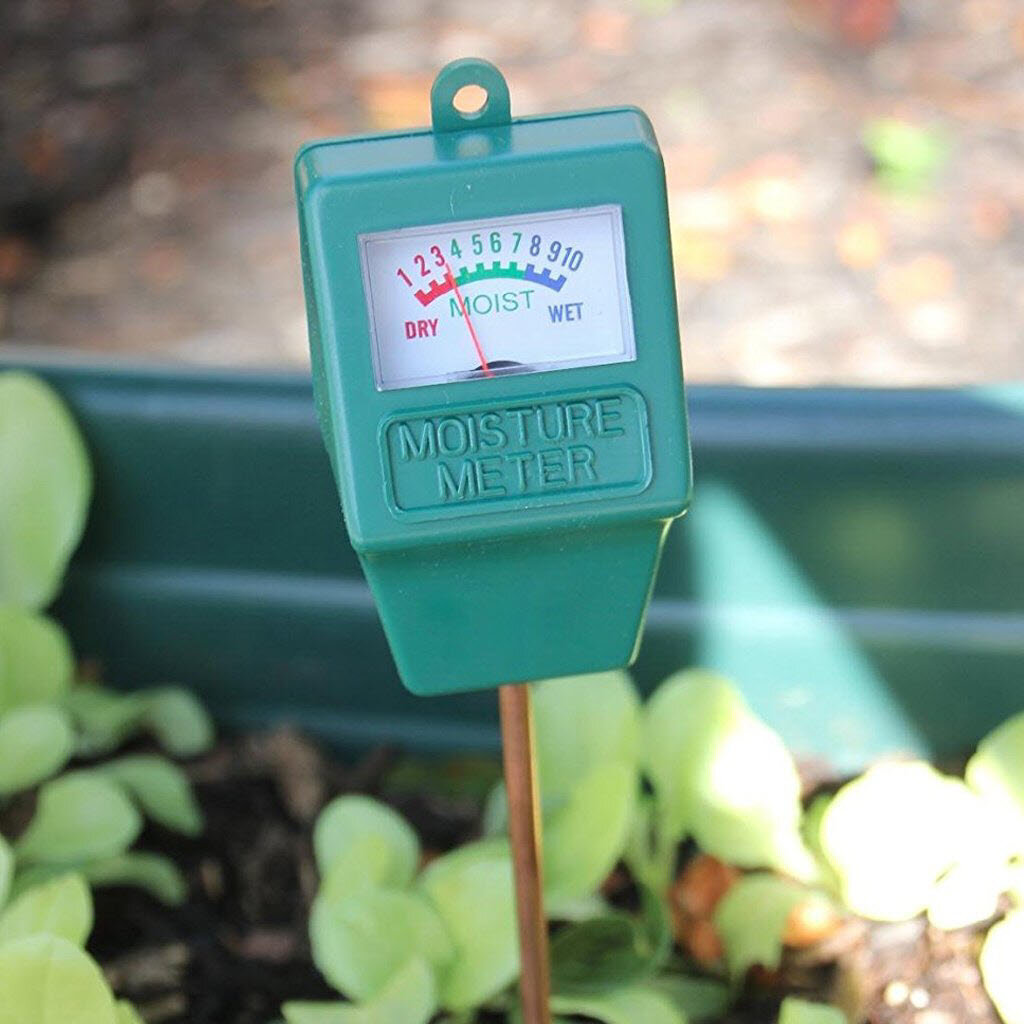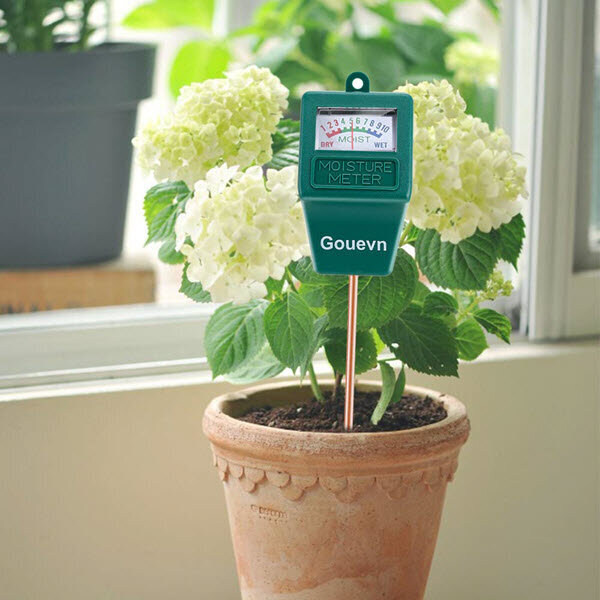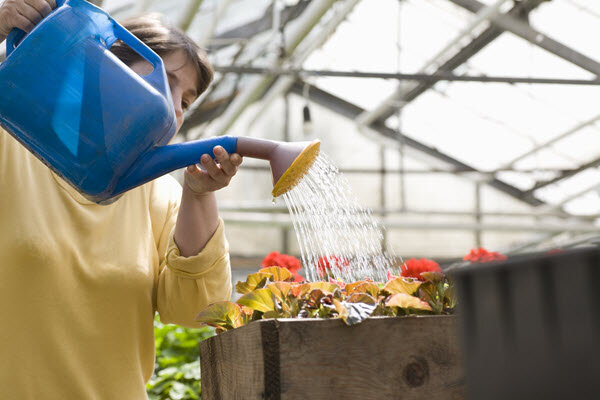Table of Contents
When I had first started gardening, I used to think of myself as having a black thumb. This was after killing one succulent, some onions I had proudly grown from scraps, and one very expensive fiddle fig tree.
The first was a particularly painful experience as I had brought the succulent home from my grandmother’s funeral. I was going to keep it alive in loving memory of the person who raised me, or so I thought till I watered it to death.
I killed my fig tree by underwatering - that’s when I bought a moisture meter. It would save all my plants thereafter and later give me a sense of how much water my plants really needed each day depending on the seasons.
If you’re warring between wilting and waterlogging, then you’ll find these water meters to be lifesavers.
Best Moisture Meters for Beginner Gardeners
I’ve scoured the internet to find the best moisture meters for your plants. Below is a list of my top five reviewed:
XLUX T10 Soil Moisture Sensor Meter - Most Popular
If you’re looking for a dedicated water meter, then the XLUX is what I highly recommend. Within seconds of sticking the probe into a pot of soil, you’ll immediately know just how dry or wet your soil is on a range of 1 to 10 with 0 being the driest. No more probing with your fingers and getting dirt in your nails.
The back of the box shows a list of plants and how much moisture content is recommended for each. For example, a rubber tree is a 4 or 5.
As much as I love spending time in my garden, there are occasions when other areas of home life need my attention. What’s handy about this instrument is that watering the plants doesn’t have entail guesswork.
Pros
Simple to operate because it only measures moisture
Color-coded reading system
Suitable for both indoors and outdoors
Impressive accuracy
Single probe unlike multi-featured test meters with two probes so there’s less potential for root damage
Cons
If you’re looking to measure light and pH, then this is not for you
The plant list was arranged by zones. It would have been easier to locate a plant by listing all the plants alphabetically and then writing its zone opposite the name.
Atree Water Meter - Most Affordable and Best for Multi-Info
I’m sure I’m not the only to poke my fingers into a pot of soil just to check if I need to water some plants.
The thing is, using this method won’t tell you what’s going on down at the roots. The Atree analog moisture meter is more or less accurate, taking away the guesswork, which should prevent you from overwatering.
The best thing about this brand is the price. I was actually surprised how well it worked given that it’s half the price tag of all the water meters on this list and it’s a 3-in-1 to boot. It combines multiple readings—soil moisture, pH and to ensure your favorite blooms are receiving the right ratio of sun and shade to thrive—sunlight.
Pros
Ideal for indoor plants
Extremely user-friendly
Lightweight
One of the best moisture meters for beginner plant lovers
Low price yet it’s a 3-in-1 as well measuring moisture, light, and pH
Very high satisfaction ratings from other buyers
Cons
Durability not guaranteed
Gouevn Moisture Meter - Best for Big Pots
If you have big pots on your patio, you should check out this moisture meter. It features a longer probe sensor which is great for plants with deep roots.
This meter, made by Gouven, is also an excellent tool for your garden, lawn or farm. It has a large dial with a colored scale, providing a very easy readout. If you are a senior with less than perfect vision or just generally have poor eyesight, the display on the Gouven is easier to read compared to others.
This meter is very straightforward to use, which could also be ideal for first-time gardeners and plant owners.
Pros
Lengthy probe sensor
Simple to use
Includes a watering guide for 200 plants
Large display
Cons
It doesn’t feature a soil pH level and light measurement
Classy Casita - Prettiest Water Meter + Best for Gifting
Once you window shop for water meters, you’ll start to realize that they all look basically the same. These devices all have green bodies with the aluminum probe. Well, all except the Classy Casita. The Classy Casita lives up to its name. It’s the prettiest moisture meter I’ve ever seen and I’ve been mine for years.
It has a white body instead of the green plastic and comes in the prettiest box. The box it comes in isn’t only super aesthetic. It has step-by-step instructions on how to use and a requisite plant watering guide. Both are in a format that’s very easy to read and understand.
Another bonus is that it comes with an eBook. This is very handy for beginner gardeners as I remember having to search up the Internet for more information on water meters and how to water the right way.
Because of how pretty it is and how great it works, it makes a great gift for newbie plant parents in your friends circle.
Pros
Packaging is the best amongst the other water meters
Works very well (The complaints I’ve seen were not using their water meters correctly.)
The seller really makes a big effort to teach how to use the product correctly and how you can water your plants properly
Cons
Not 3-in-1
Sonkir Soil pH Meter - Best pH Meter
I’m not gonna lie to you. All the meters on this list are basically the same in that they do the same function. The single-feature meters measure moisture, and the 3-in-1 meters measure light, pH, and moisture. In terms of quality, I chose the best so they all do the job well. The major points where they differ would be price and looks. As you can see, this Sonkir meter with its black body and gold-colored probe makes it appear different from the rest of the usually green water meters.
And yet, what makes this Sonkir special is not its looks. I was actually quite surprised but the pH meter on this one works very well. I didn’t really think a ten-dollarish probe could effectively measure pH levels but it does, and other satisfied buyers feedback the same thing.
So, if you’re needing a tester for pH levels, get the Sonkir.
Pros
3-1 function tests moisture, pH and sunlight level
Good feedback on the accuracy of pH readings
Will work for both indoor or outdoor
Cons
May take time to settle in on pH readings
BONUS: The SUSTEE Pen - Color-Based No-Damage Aquameter
Just like all the water meters on this list, the SUSTEE pen helps you know when it’s time to water your plants. There are big differences though.
For one, you use one pen for each plant. This cuts down on accidental root damage whenever you take a moisture reading. Another difference is that instead of a meter, it shows a plant’s “thirst” through colors. A blue color in the indicator window means your plant is happy and has enough water. A white color means you need to water right away.
All in all, this is very interesting patented Japanese technology. You can read our full review here.
We’ve linked to the set of 5 but you can buy them in singles. When I got my first pens, I first got a pack of 2 just to check them out.
Common Mistakes And Misconceptions About Moisture Meters
There’s a lot of wrong information floating around about moisture meters. I want to make sure that you understand these tools well before using one.
If you haven’t purchased one yet, it might help you understand the (sometimes) incorrect feedback that buyers sometimes make about these tools. And if you’ve already made a purchase, the info below should help you make your water meter last longer.
Don’t test a moisture meter by sticking it into a glass of water.
It seems to happen fairly often that a new owner of a moisture meter would stick their gadget into a glass of water to see if it works. Newsflash: It’s not designed this way. The probes are engineered to measure moisture in soil, not water.
If you must test, test it in a pot of dry soil versus very moist soil. Compare the readings of each.
You can get differing zone readings from one pot of soil or plot of land.
Water distributes unevenly in a pot because of factors like soil compactness, type, and the plants’ root structure. So, some portions may register as wetter and others dryer. Sometimes, the water just stays on top and doesn’t filter down to the bottom of the pot. This is why some gardeners recommend burrowing holes into your pots so you can trickle your water into these holes and ensure it reaches to roots that are further down.
In the event of overwatering potted plants, make sure your plants can drain off excess water so they don’t drown. If you garden indoors, like in a condominium, you can set up a DIY drainer using a big basin and a stool. Place your potted plant in a sunny nook to help further the drying process along.
You can’t force-push the probes into soil; you’ll break them
A lot of new users end up breaking their gadgets because they pushed their water meters into hard soil. These meters are fragile and the probes are constructed for sensitivity, not strength. Thus, if the soil is too hard and compacted, the probes are likely to break off if you apply too much force.
If you are using a moisture meter regularly on your plants, keep the soil loose so that the probes can slide in easily. Loose soil is also good for plants because air and nutrients can circulate better.
It always has to be clean and dry
Don’t leave your meter stuck into soil for hours on end and don’t leave it outside in inclement weather. As I’ve mentioned, these gadgets are sensitive. A reading is instantaneous (or takes a couple of minutes for a stubborn pH reading) and after that, you need to take it out and clean it. Otherwise, the probes will end up rusting and unusable.
Prolong the life of your tool by drying it and wiping it clean immediately after use.
Case in point, here’s a comment I stumbled across on YouTube:
How To Use A Moisture Meter (Video Demo)
To find out how to use a moisture meter, here’s a short demonstration:
How To Choose A Moisture Meter
When searching for one of the best moisture meters, here are a few things to keep in mind:
Easy-to-read display
Being able to view and understand the results clearly and simply, without requiring a science boffin to assist, will help you identify moisture levels quickly—saving you time and effort.
Reading accuracy
You don’t want to kill your gorgeous gardenias over a misread. The best moisture meters should provide reliable measurements. The gadgets on this list all give fairly accurate readings.
Available features
Do you only need to check on water levels? Or, will you also benefit from light and pH readings? Get the single-feature ones for the former and the 3-in-1 meters for the latter.
Location and type of gardening
Research the types of plants and soil in your garden, as in some cases, you may have different measurement requirements. Cacti and aloe like dry soil while azaleas and begonias love water.
Types of Moisture Meters
There are many moisture meter types available on the market. Here’s a little more detail on what you may come across:
Analog
These meters have a simple design and are very effective. They don’t need batteries, as they work with electricity that naturally occurs in the soil.
The water present in the soil transmits to the tip of the probe, emitting a charge on the meter, which produces the reading.
All of the meters on this list are analog.
Digital
Digital moisture meters work with batteries, providing power to the screen display.
One difference is that their probes aren’t subject to corrosion like their analog counterparts. This means it's not so crucial if you forget to remove them from the soil.
Some can also be charged via USB cables. These take the inputted data and transfer it to your computer. Through different software, you can use this information to analyze moisture changes in your soil.
Wicking
These devices are popular for use with house plants. They absorb moisture from the soil, drawing it upward to a string of fabric which changes color. As the soil dries out the color fades—and that’s your cue.
These hydrometers are designed to remain in the pots, conveniently letting you know when it’s time to water just by looking at them. Unfortunately, they don’t perform well outdoors or in direct sunlight.
Hybrid
Hybrid meters provide gardeners with many details, mainly on soil hydration and sunlight needs. A soil pH meter is also often included. You will find both digital and analog versions of this type. In some cases, they also include ambient temperature or testing time.
These meters are handy for composting because the soil needs to have a certain amount of hydration to boost microbial growth. With a meter probe, you don’t need to get your hands dirty to know the moisture level.
The Best Moisture Meters: Final Thoughts
Knowing when to water your plants may be tricky, especially for first-time plant owners. To keep your plants healthy and happy, you want to find a middle ground—not under or overwatering.
The best moisture meters form a valuable tool for any gardener’s armory.
My top pick turned out to be the XLUX T10 for the single-feature moisture meter. I feel it gives the most accurate readings out of all the moisture meters and it’s also assuring that it’s go-to brand and model for other buyers. For the 3-in-1 meters though, my preference is the Sonkir because of the accurate pH readings. It’s really helped me manage the soil in my potted plants and lawns.
Other Essential Gardening Tools



















